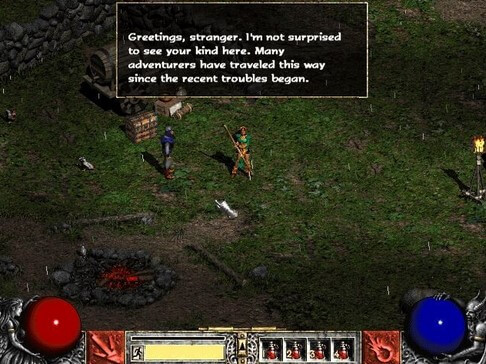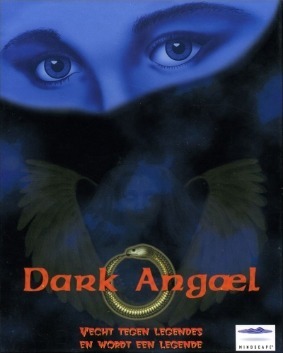Diablo II is an action role-playing hack-and-slash computer video game developed by Blizzard North and published by Blizzard Entertainment in 2000 for Microsoft Windows, Classic Mac OS, and macOS. The game, with its dark fantasy and horror themes, was conceptualized and designed by David Brevik and Erich Schaefer, who, with Max Schaefer, acted as project leads on the game. The producers were Matthew Householder and Bill Roper.
Building on the success of its predecessor, Diablo (1996), Diablo II was one of the most popular games of 200 and has been cited as one of the greatest video games ever made. Major factors that contributed to the game's success include: its continuation of popular fantasy themes from the previous game, and its access to Blizzard's free online play service, Battle.net. An expansion to the game, Diablo II: Lord of Destruction, was released in 2001. Another sequel in the series, Diablo III, was announced in 2008 and released on May 15, 2012. Diablo Immortal, the fourth installment in the series, was announced during Blizzcon 2018 and is set after Diablo II: Lord of Destruction.
Gameplay
Diablo II's storyline progresses through four chapters or "Acts". Each act follows a predetermined path, but the wilderness areas and dungeons between key cities are randomly generated. The player progresses through the story by completing a series of quests within each act, while there are also optional side dungeons for extra monsters and experience. In contrast to the first Diablo, whose levels consisted of descending deeper and deeper into a Gothic-themed dungeon and Hell, Diablo II's environments are much more varied. Act I is similar to the original Diablo; the Rogue Encampment is a simple palisade fort, while plains and forests making up the wilderness area, and the Monastery resembles the typical Middle Ages fortress. Act II mimics Ancient Egypt's desert and tombs; Lut Gholein resembles a Middle Eastern city and palace during the Crusades. Act III is supposedly based on the Central American jungles; Kurast is inspired by the lost Maya civilization. Act IV takes place in Hell and is the shortest, with just three quests compared to the other Acts that have six.
The Lord of Destruction expansion adds the fifth chapter Act V which continues the story where Act IV left off. Act V's style is mainly mountainous as the player ascends Mount Arreat, with alpine plateaus and icy tunnels and caverns. Occasional portals can take the player to dungeons in Hell (seen in Act IV) for extra monsters and experience. After reaching the summit of Arreat, the player gains access to the Worldstone Keep (whose architecture may be reminiscent of Angkor Wat and other Hindu temples).
In addition to the acts, there are three sequential difficulty levels: Normal, Nightmare, and Hell; completing the game (four Acts in the original or five Acts in the expansion) on a difficulty setting will open up the next level. On higher difficulties, monsters are more varied, stronger and may be resistant or immune to an element or physical damage; experience is penalized on dying, and the player's resistances are handicapped. However, better items are rewarded to players as they go through higher difficulties. A character retains all abilities and items between difficulties, and may return to a lower difficulty at any time, albeit it is not possible to re-play the quests that are already completed.
Players can create a hardcore character. In normal mode, the player can resurrect their character if killed and resume playing, while a hardcore character has only one life. If killed, the character is permanently dead and unplayable. In addition, all items and equipment on that character will be lost unless another friendly character has the "loot" icon checked. Standard and hardcore characters play on separate online channels; as such a hardcore player can never appear in the same game session as a standard player.
Item system
Diablo II uses a system of randomly generated equipment similar to the original Diablo, but more complicated. Weapons and armor are divided into several quality levels: normal, magical, set, rare and unique. Normal quality items are base items with a fixed set of basic properties, such as attribute requirements, maximum durability, armor rating (on armor), block chance (on shields), damage and attack speed (on weapons). Magical quality items have blue names and one or two randomly selected bonuses, such as bonuses attributes, skills or damage, indicated by a prefix or suffix. Rare quality items have randomly generated yellow names and 2 to 6 random properties. Unique items have fixed names in gold text, and instead of randomized properties, they have a set of 3 to 8 preselected properties. Green-named set items have fixed names and preselected properties like unique items, and belong to specific named sets of 2 to 6 items. Additional properties known as set bonuses are activated by equipping multiple or all items from the same set. These are themed on individuals, like Civerb's cudgel, shield and amulet each provide individual bonuses which are enhanced if two or more of the items are used to equip a character. It is unusual to encounter more than one item from a set in a single playthrough of the game, so collectors need to play the game many times to accumulate all items from a set, or purchase them online from other players who possess them but do not need them. Additionally, items can pos
Diablo II includes an item crafting system. An item known as the Horadric Cube is used to combine two or more items to create a new item. For example, 3 identical lower quality gems can be combined to create a single higher quality gem, and 3 small rejuvenation potions can be combined to create a single, more powerful rejuvenation potion.




















